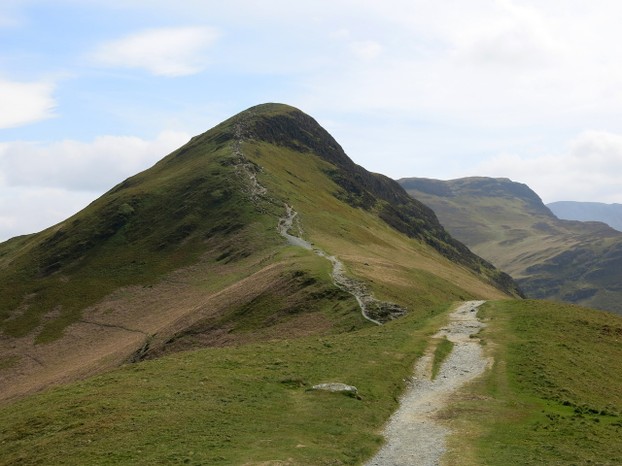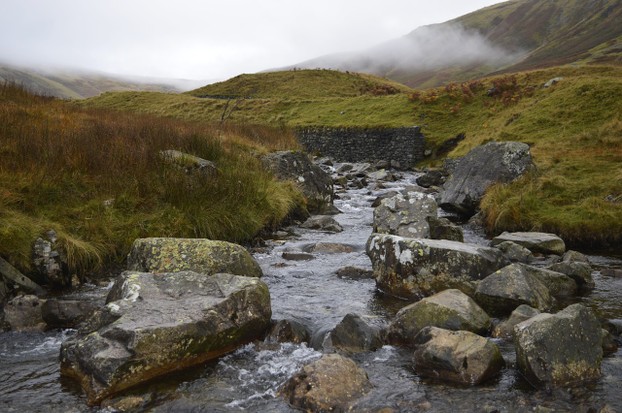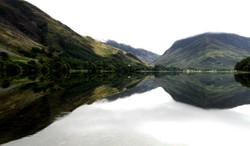This is an uncompromising mountainous area where the road ascends and descends through a harsh moorland. The slopes on either side are steep and rocky, and part of the route runs past old slate mines where men tunnelled neath the ground to extract Britain's roofing materials, until the mines closed some years ago.They opened again recently, but much of the mine zone high in the cliffs is used for adventure sports.
The land is,as you can see from the picture, prone to mists and rain, and at the far end is Seathwaite, England's rainiest village.It was misty that day and my father and I talked as we walked. We discussed religious matters, for Dad was deeply and genuinely religious, a man who spent his pension years serving the church before ill-health claimed him. Yet he was something of a paradox, a war time reconnaissance trooper,in a unit considered one step below commandos,he had seen much action, but it never sullied his religious piety. A faith that stood the test! As boys we wanted tales of war, and he gave us some, but it was only in later years that I realized how hard the conflict had been for him, a sensitive man forced by circumstance to do what he did not want to do.
He had learned his first bird watching skills when on duty with the army in Scotland, and on our walk he showed me my first heron. His alert eye spotted the flight when I had seen just a bird. " A heron" he declared and pointed, and I saw the large,wide-winged creature flying over the beck [stream.] I have seen many a heron since then, as they are common in my watery area with its canals and rivers, but at the back of my mind lurks my first experience of one,and that came from my father.
We also did a good deed. Encountering two very nice and vulnerable elderly ladies whose three wheeler car was stuck trying to ascend the pass, we stepped in to help. The hill start on the steep slope was too much for them, and they needed assistance. Dad was mainly Irish by blood and had the short,broad ,muscular physique of many Irish, a physique that he has passed on to me, so the two of us exerted our muscle to get the two nice ladies started. They waved as the car set off, and we never saw them again.
No more of note happened on that stage of the walk and we descended to Seathwaite, where being English we just had to get a cup of tea.









 Pilgrimage. A reviewon 06/15/2025
Pilgrimage. A reviewon 06/15/2025
 Leo the Fourteenthon 05/09/2025
Leo the Fourteenthon 05/09/2025
 The Melsonby Hoardon 03/25/2025
The Melsonby Hoardon 03/25/2025


Comments
To my knowledge no blue her on has found its way here.
The third paragraph to the third subheading, The Honister Pass, attributes paternal astuteness to your discerning your first heron.
My spectacularest discernment happened within the past few years.
My feline sentients made sounds that I hadn't heard previously from the bathroom windowsill. I noticed a great blue heron (Ardea herodias) in the west-yard creek from the vernal pool.
The Caribbean, Central, North, South American wading-bird species sometimes occurs as a rare vagrant in the Azores and in unspecified European countries.
Would you know them to wend their rare-vagrant way to the British Isles?
Indon't know then answer tomthisbquestion..
Thank you!
English Wikipedia contains an article covering British overseas territories. Its entry on South Georgia and the South Sandwich Islands includes brief reference to the Argentine occupation during the 1982 Falklands War.
Argentine driving is on the right side of their road system.
Might you know whether or not the Argentine occupiers reversed or tolerated left side-driving?
It follows the U K pattern.
Thank you!
English Wikipedia cautions that British Overseas Territories, Isle of Man, Jersey and Northern Ireland follow road-numbering schemes different from the mainland system.
Does, for example, Northern Ireland's road-numbering scheme differ maximally or minimally from the mainland system?
(So might mainlanders dread or embrace Northern Ireland's road classifications?
The standard British classification of roads appliesvto all roads in mainland MAINLAND Britain.
The second paragraph to the first subheading, The first stage, describes transportation routes as B roads.
English Wikipedia discusses them in its article Great Britain road numbering scheme.
The aforementioned article identifies that scheme as different from British Overseas Territories', Isle of Man's, Jersey's and Northern Ireland's.
Might the above-mentioned exclusions observe quite different or quite similar road numbering schemes?
No. All were the same to him.
It seems like your father showed a true treasuring of such beautiful nature as avian sentients.
Would he have had a favorite species, genus or family?